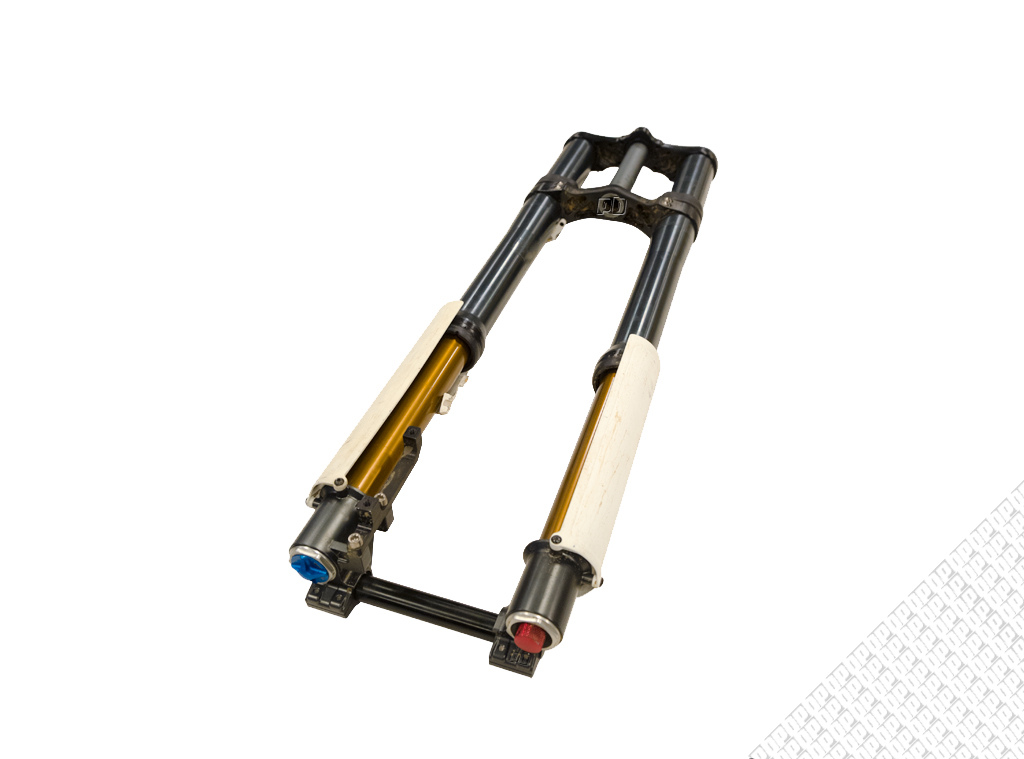
Fox's prototype inverted DH fork whipped up a storm of excitement, but it isn't looking like the upside down slider will be hitting the production line.
Pinkbike gave you the first look at Fox's inverted DH fork when Gee Atherton did an early morning practice run at the US Open with it bolted to the front of his bike. It garnered a massive amount of attention, and we took some bold guesses as to the details of the prototype slider, but Fox shared the real story with us during our visit to their new building in Scotts Valley, California. According to Fox, there were a few different versions being tested under their RAD (Racing Application Development) program, mostly under Gee and Aaron Gwin, that focused more on chassis performance than any new damper technology. While it utilizes the same 40mm diameter Kashima coated stanchions as the "standard" factory racing program Fox 40, there were a number of different axle setups that were investigated on track. Fox didn't elaborate on that last point, but we would have to assume that they are either referring to a larger diameter axle, or possibly even a non-round version, in an effort to increase torsional stiffness (the fork pictured uses a standard 20mm axle setup).
We were told that this particular version uses the same FIT RC2 internals as a team version of the Fox 40 would, although we wouldn't be surprised if there are some far from standard components inside. The spring leg in particular looks to use a different arrangement, with its preload dial at the bottom of the leg and a 5mm hex bolt at the top. The preload dial clearly means that the fork is coil sprung, but the 5mm hex bolt could possibly be some sort of air volume adjustment feature, or maybe serve an entirely different function.

Standard FIT RC2 damping? Maybe in the fork pictured here, but you can bet that Fox tested other internals as well.
The outcome? After much testing it was decided to discontinue development of the inverted fork, simply because Fox couldn't attain the torsional stiffness that they were looking for without it becoming much too heavy for their liking. Word is that both Gee and Aaron were big fans of how the prototype fork handled fast, rough sections of trail head on - thanks to the increased fore/aft stiffness of the inverted design - but felt that the standard right side up arrangement of the current Fox 40 had the inverted fork soundly beaten in the corners. Fox admitted that they could likely remedy this by added more material, but the fact of the matter is that the majority of competitive downhillers would likely balk at purchasing a new fork that weighs substantially more than what they are currently using, even if it did offer advancements in damper technology or other areas.
While there are surely going to be riders out there who are disappointed that they won't be able to ride an inverted Fox fork anytime soon, Fox doesn't look at this project as a failure, but rather an exploratory exercise to learn from. You may never be able to use one of these forks, but you may be riding suspension technology in the near future that owes some of its DNA to the fork pictured above.
www.foxracingshox.com
*** All Rights To Pinkbike.com